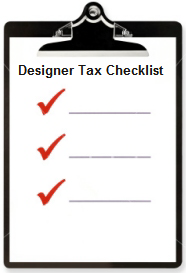Independent web designers are best known for their creativity, but business knowledge has a crucial role to play when it comes to taxes. Making necessary business purchases before the end of 2010 and making the appropriate use of deductions can help save you cash when tax time rolls around.
 Acceptable tax deductions
Acceptable tax deductions
The IRS requires that business deductions be “ordinary and necessary” for your profession. As a self-employed web designer, you’re running your own business, so you can take advantage of business deductions appropriate for your line of work. Those would include office supplies, mileage for travel to client meetings, professional books and journals, and means of communications such as cell phones and the Internet.
It’s also important to keep in mind that only a portion of some purchases can be written off. If you buy new fonts for a project and use them half the time for work and half the time for personal use, you can deduct half the cost of their purchase price. The same goes for things like landlines lines and Internet connections. You need to estimate how much you use them for business use, and deduct that portion.
Deductions vs. depreciation
For bigger ticket items, like computers, you can depreciate the purchase over five years or deduct the entire amount the year they’re purchased. To determine what’s best, consider how your income might change over the next five years and where you think tax rates might be headed. You always want the largest deductions when income and tax rates are highest.
Working from home
As an independent contractor, you’re likely to work from home. If you have a dedicated home office, you can write off the expenses related to it. Say your home is 1,500 square feet, and your office is 150 square feet, you can deduct 10 percent of your mortgage or rent, utilities, insurance, real estate taxes, and similar expenses.
Tracking Expenses
It’s always easiest to keep track of expenses during the course of the year, rather than digging through a stack of receipts. While you can use an Excel spreadsheet, a number of web-based programs are available. Shoeboxed is the most applicable for someone who is self-employed. Send in your receipts and Shoeboxed extracts the amount, date, vendor name and payment type, and assigns each receipt to a tax categorize. You can also create custom categories for your receipts.
About the Writer
Susan Ladika has been a writer and editor for 25 years. Her freelance work has covered everything from business to travel to science to international issues, and have appeared in such publications as Science, Town & Country, HR Magazine, Developer, The Wall Street Journal-Europe, The San Francisco Chronicle, and many others. She has also done extensive editing as a newspaper and wire service editor holding positions such as the Tampa Tribune Bureau Chief.
More Tax Questions?
Related Articles
->Will a Roth IRA Conversion Trigger Self Employment Tax?
->1099 Form Filing Requirements For 2012
->Should A Teacher Share Their Business Tax ID Number?
->Should I Withhold Taxes From Employee Checks?
->How Do I Treat a Discount For Bookkeeping Purposes?
->Can I Purchase a Vehicle Through My Business?
->Do I Issue a 1099 or W2 to My Employees?
->Are Vehicle Start-up Costs Tax Deductible?
->Separating Personal Assets From Business Assets
->Choosing the Right Tax Preparer For Tax Help
->New To The LLC? Tax Consultants Are Here to Help



